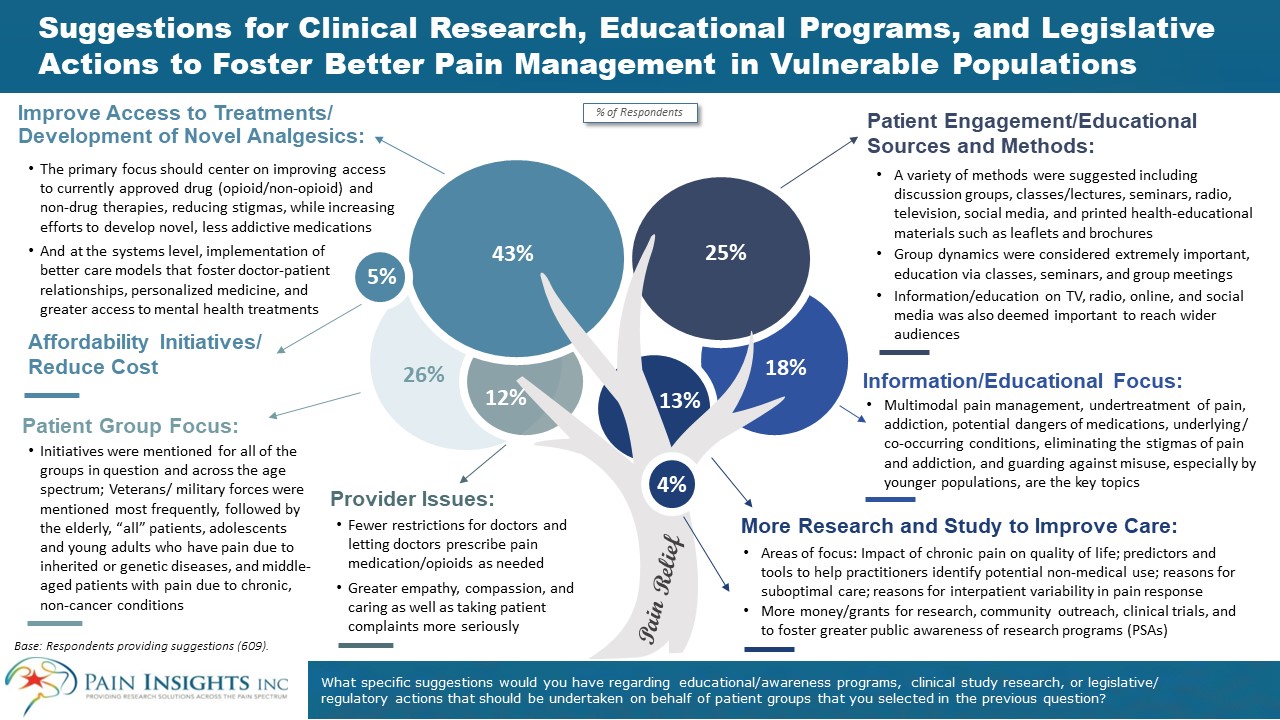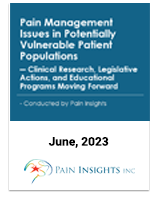Pain Management Issues in Potentially Vulnerable Patient Populations ― Clinical Research, Legislative Actions, and Educational Programs Moving Forward
Pain Insights, Inc. announces a comprehensive market research study conducted among 1,147 sufferers of recurrent and chronic pain.
View video presentations of results
Pain Insights conducted a patient-centered survey to better understand the needs of patients with recurrent and chronic pain, review pain management needs in potentially vulnerable patient populations across the lifespan, such as Veterans, the elderly, unborn children, and those with genetic diseases, and to present information on potential pain-related initiatives.
Reactions were also obtained to changes that could be made in updates to the 2016 CDC “Guideline for Prescribing Opioids for Chronic Pain.” The guideline was intended to provide recommendations for primary care clinicians on appropriate opioid use but has also been ascribed to barriers to adequate care. In addition, recent information was presented on the amount of illicit drugs coming into the country and views on potential impact this has had on patients being treated for chronic pain were obtained.
The internet-based survey was completed by 1,147 patients suffering from recurrent or chronic pain.
To provide context, numerous representative patient verbatims are included.
Survey Outline:
- Overall benefit of current pain management regimens.
- Aspects of life that are negatively impacted by current health status.
- Changes in access to pain therapies/availability in the past 12 months.
- Groups currently most at risk of not receiving adequate pain treatment.
- Funding to support the study of regenerative rehabilitation in Military Service Members and Veterans, accelerating development of therapies for painful rare diseases, and legislation to protect unborn child capable of experiencing pain.
- Awareness/Impact of the 2016 CDC opioid prescribing guidelines and need for revisions.
- Opinions on illicit drugs coming into the country and impact on patients with chronic pain.
- Suggestions regarding educational/awareness programs, clinical study research, or legislative/regulatory actions that could be undertaken for groups at risk.
Sample Findings
- Pain management was deemed suboptimal in half of pain sufferers, while at the same time, little change was seen in availability or access to pain therapies in the past six months, in fact, access worsened for one-quarter of individuals.
- The elderly population, military Veterans, and middle-age patients with chronic, non-cancer pain were mentioned most frequently as populations at risk of not receiving adequate treatment “a moderate amount-great deal.”
- Women reported significantly higher interference on 12 of 17 activities of daily living, consistent with NCHS high-impact chronic pain studies.
- 83% of individuals with a “basic” or “good” understanding of the CDC guidelines recommended that they either be “modified/revised” or “completely repealed/withdrawn.”
- 73% of respondents agreed that the amount of illegal drugs (e.g. fentanyl) coming into America has negatively impacted patients with chronic pain.
- Funding larger studies to confirm potential “synergistic” benefits of regenerative and rehabilitation medicine in active MSMs/Veterans was favored by 78% of respondents. Assuming confirmation, there is almost universal support (94%) for expanding access to these therapies for Veterans in settings outside of Veterans Affairs (VA) facilities.
- The concept of a legislative act that accelerates development of therapies for rare diseases was favored by 71% of respondents.
- 84% of individuals were “moderately-extremely” supportive of research to better understand fetal pain and potential longer-term ramifications of painful experiences.
- Almost twice as many respondents supported a base case concept description of legislation to protect unborn children capable of experiencing pain (43% support vs. 24% opposed) while 34% were undecided. And several avenues exist to further increase support. Irrespective of legislation, programs providing counseling and mentoring, supplies for mothers, greater access to adoption, church led crisis support, and post-abortion counseling, if needed, had strong support.
Patient recommendations for better pain management:

What is the value of this study? - The findings will lend insights into: patient engagement activities, patient-reported outcomes (PROs), pain in vulnerable populations, new product development, educational initiatives, legislative actions, and strategic planning strategies.

